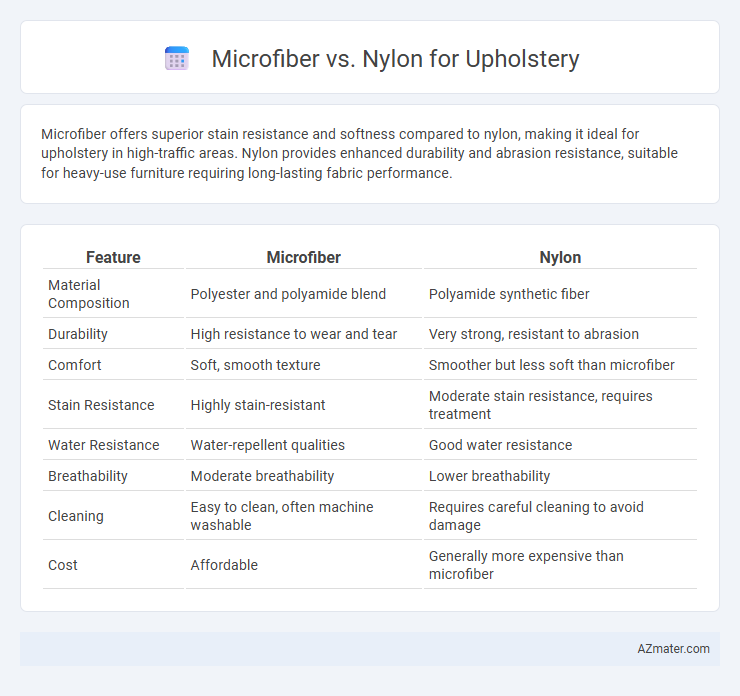Microfiber offers superior stain resistance and softness compared to nylon, making it ideal for upholstery in high-traffic areas. Nylon provides enhanced durability and abrasion resistance, suitable for heavy-use furniture requiring long-lasting fabric performance.
Table of Comparison
| Feature | Microfiber | Nylon |
|---|---|---|
| Material Composition | Polyester and polyamide blend | Polyamide synthetic fiber |
| Durability | High resistance to wear and tear | Very strong, resistant to abrasion |
| Comfort | Soft, smooth texture | Smoother but less soft than microfiber |
| Stain Resistance | Highly stain-resistant | Moderate stain resistance, requires treatment |
| Water Resistance | Water-repellent qualities | Good water resistance |
| Breathability | Moderate breathability | Lower breathability |
| Cleaning | Easy to clean, often machine washable | Requires careful cleaning to avoid damage |
| Cost | Affordable | Generally more expensive than microfiber |
Understanding Microfiber and Nylon Fabrics
Microfiber fabric, made from ultra-fine synthetic fibers typically polyester or nylon, offers exceptional softness, durability, and stain resistance, making it ideal for upholstery. Nylon, a strong synthetic fiber known for its elasticity and abrasion resistance, provides durability but tends to be less soft and more prone to static buildup compared to microfiber. Both materials are valued in upholstery for their resilience, yet microfiber's fine weave and superior soil repellency often result in easier maintenance and longer-lasting appearance.
Durability Comparison: Microfiber vs Nylon
Microfiber for upholstery offers superior durability due to its tightly woven synthetic fibers that resist wear, stains, and fading better than nylon. Nylon, while strong and abrasion-resistant, often shows signs of pilling and color fading faster under heavy use compared to microfiber. Microfiber's resistance to moisture and ease of cleaning further enhance its long-lasting performance in high-traffic upholstery applications.
Stain Resistance: Which Upholstery Wins?
Microfiber surpasses nylon in stain resistance due to its tightly woven synthetic fibers that repel liquids and prevent spills from penetrating the fabric. Nylon, while durable, tends to absorb stains more readily because of its looser weave and higher absorbency. For upholstery in high-traffic or spill-prone areas, microfiber offers superior protection and easier maintenance, making it the preferred choice for stain resistance.
Comfort and Texture: A Side-by-Side Analysis
Microfiber upholstery offers a soft, suede-like texture that feels smooth and cozy, making it ideal for comfort-focused furniture. Nylon, while durable and stain-resistant, tends to have a firmer, less plush surface that may feel cooler to the touch. The choice between microfiber and nylon hinges on the desired tactile experience, with microfiber excelling in softness and nylon in resilience.
Cleaning and Maintenance Differences
Microfiber upholstery is highly resistant to stains and requires only mild soap and water for cleaning, making it ideal for low-maintenance environments. Nylon, while durable, tends to attract more dirt and oils due to its synthetic fibers, often needing stronger cleaning agents and more frequent upkeep. The dense weave of microfiber also prevents dirt from embedding deeply, whereas nylon's looser structure can trap debris, resulting in increased maintenance efforts over time.
Color Options and Fading Resistance
Microfiber upholstery typically offers a broader and richer palette of color options compared to nylon, making it easier to match diverse interior design schemes. Microfiber also excels in fading resistance due to its dense weave and synthetic fiber composition, maintaining vibrant colors even under prolonged exposure to sunlight. Nylon, while durable, is generally more prone to color fading over time, especially in high-traffic or sunlit areas, limiting its appeal for long-lasting color vibrancy in upholstery.
Pet Friendliness: Microfiber or Nylon?
Microfiber upholstery is highly pet-friendly due to its tightly woven fibers that resist scratches and prevent pet hair from embedding deeply, making cleaning easier. Nylon offers strong durability but tends to attract and hold onto pet hair more than microfiber, requiring more frequent maintenance. For households with pets, microfiber is generally preferred for its stain resistance, softness, and ease of cleaning compared to nylon.
Cost Comparison and Value for Money
Microfiber upholstery typically costs between $5 and $15 per yard, offering exceptional stain resistance and durability, which translates to long-term savings and enhanced value for money. Nylon fabric ranges from $10 to $20 per yard, providing strong wear resistance but less effective stain protection, often leading to higher maintenance expenses. Considering durability, ease of cleaning, and initial investment, microfiber generally delivers superior cost-efficiency for upholstery applications.
Eco-Friendliness and Sustainability Factors
Microfiber upholstery, often made from finely woven polyester, typically has a lower environmental impact due to its durability and resistance to stains, reducing the need for frequent replacement and chemical cleaning products. Nylon, while strong and abrasion-resistant, is derived from petrochemicals and has a higher carbon footprint during production, making it less sustainable compared to eco-conscious microfiber variants crafted from recycled materials. Choosing microfiber made from recycled fibers or those with eco-certifications can significantly enhance the sustainability profile of upholstery in comparison to conventional nylon fabrics.
Choosing the Best Fabric for Your Lifestyle
Microfiber offers exceptional stain resistance and durability, making it ideal for households with pets or children, while nylon excels in strength and abrasion resistance, suitable for high-traffic areas. Consider microfiber for its soft texture and ease of cleaning, contrasted with nylon's resilience and ability to maintain vibrant colors over time. Selecting the best fabric depends on balancing comfort, maintenance needs, and daily wear specific to your lifestyle.

Infographic: Microfiber vs Nylon for Upholstery
 azmater.com
azmater.com